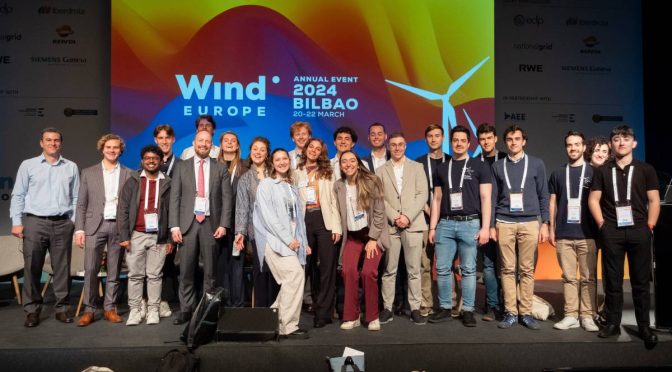Last week, the Wind Europe Annual Event returned to Bilbao after the editions of 2019 and 2022. It’s the third time in Bilbao, with an increasingly larger deployment in every aspect.
If there’s one thing that has stood out in this edition of Wind Europe, it’s that nothing has particularly stood out, if that’s even possible.
Nevertheless, here’s an overview of the most relevant points:
Our wind, our value
If last year’s message was focused on increasing volume (accelerating permitting, scaling the supply chain, expanding and improving the grid…), this year the narrative was different.
The theme of the edition and the presentation video projected during the opening session made it clear: Our wind, our value.
Although without many direct references, the message this time has focused on defending and protecting the European wind industry, highlighting the success story that this industry represents on the old continent and placing the value it generates above the price.
_
No news on wind turbine presentations
Similar to last year, there have been no presentations of new wind turbine models. Enercon opted to unveil its new E-175 EP5 with a power of up to 7 MW just before the fair, and that’s the most relevant development in terms of new products lately.
However, backstage rumors suggested that at Wind Energy Hamburg, next September, one of the Western OEMs could unveil an 8 MW model.
_
In every niche, a business opportunity
Specialization levels in the sector are reaching extraordinary levels. This leadsin a lot of small (and not so small) companies specialized in every niche you can imagine.
It’s also very interesting that there was a startup area, known as the Startup Pavilion. It’s worth taking a look at the list of companies and watching some of the presentation videos.
_
Floating wind continues to attract a lot of attention
Floating wind has been attracting a lot of attention for a couple of years now, and the truth is that it still does. It’s incredible the number of companies that are involved in this sector.
The truth is that the race to develop reliable and competitive floating wind technology is fascinating, and there are many stakeholders betting on and collaborating in this long-term race.
The conferences, too political
I had the opportunity to attend some of the conferences, and the truth is that this year I left a bit disappointed. Although I also believe that much of the blame lies with me, as I didn’t choose well.
The so-called high-level conferences, which feature the most important personalities and take place in the largest auditoriums, often suffer from canned political speeches and are quite disconnected from the day-to-day reality.
In one of the sessions I attended, one of the speakers even received applause after making some slightly politically incorrect statements (not too much) that deviated from the expected discourse. That applause was revealing.
I truly believe that many conferences provide a lot of value, but if I have to choose, personally, I prefer those that deal with topics closer to the reality of the business, or those that address technological trends and innovation.
_
Chinese manufacturers without stands, but present
Chinese wind turbine manufacturers don’t have stands, but I did see some accredited individuals from some of the major Chinese manufacturers moving around the fair.
If my memory serves me right, I saw people from Minyang, Envision, and Sany wandering around. It’s logical to assume that there were also some meetings between some IPPs and them.
For the moment, their foray into the European Union is more than timid, but it seems clear that they are trying.
_
Bilbao and the event
I also wanted to comment a bit on the role of Bilbao as the site for the event. Although don’t take me too seriously because it’s all based on feelings and hardly any data. So, allow me a bit of personal reflection.
The truth is that the evolution of the fair in terms of size is notable: there were talks of 8,000 attendees in 2019, 10,000 in 2022, and according to the organization, there were 12,000 for this year.
Bilbao, a medium-sized city, doesn’t seem very accustomed to hosting such a large number of people. And although I think the BEC as a venue lives up to the expectations, other city infrastructures flirt with their capacity limits (hotels, taxis, etc.). We even had the misfortune that the metro didn’t work on Wednesday morning. It’s just a coincidence, but it’s also a significant failure that doesn’t leave a good impression and affected many.
Having said that, I sincerely believe it’s a luxury, both for locals and visitors, that Bilbao becomes the capital of European wind power for 3 days. I truly believe it’s a great city to visit (and live in, although my opinion here is totally biased). Easy to get around, beautiful, with many things to see, and with enviable gastronomy.
I hope and trust that this won’t be the last edition of Wind Europe in Bilbao, although there were rumors in some circles that it could be. It would be a shame, undoubtedly. And it would be bad for Windletter
_
Personal reflections
On a personal note, honestly, this has been a very gratifying edition for me. I’ve been able to greet and put faces to many of you (whom I only knew virtually), chat with many friends, and of course, also be with the sponsors Tetrace and Renercycle, whose support makes Windletter possible.
Many of you have managed to make me blush (literally) several times with your kind words towards this publication. The truth is that this momentary “fame” (if it can be called like that) is something I still haven’t quite gotten used to.
But I truly appreciate the kind words, the kindness, and the feedback I’ve received. Except for those of you who called me an influencer, I won’t forgive you for that


